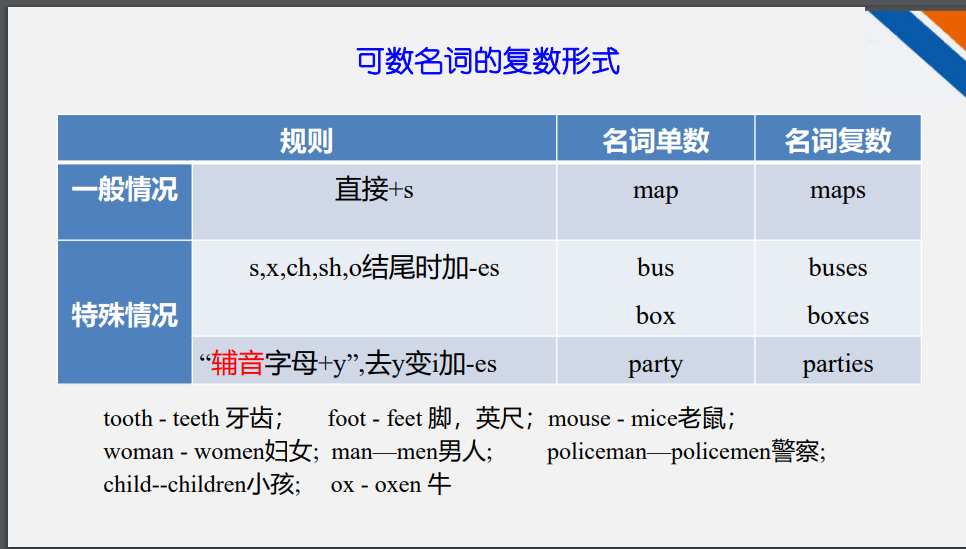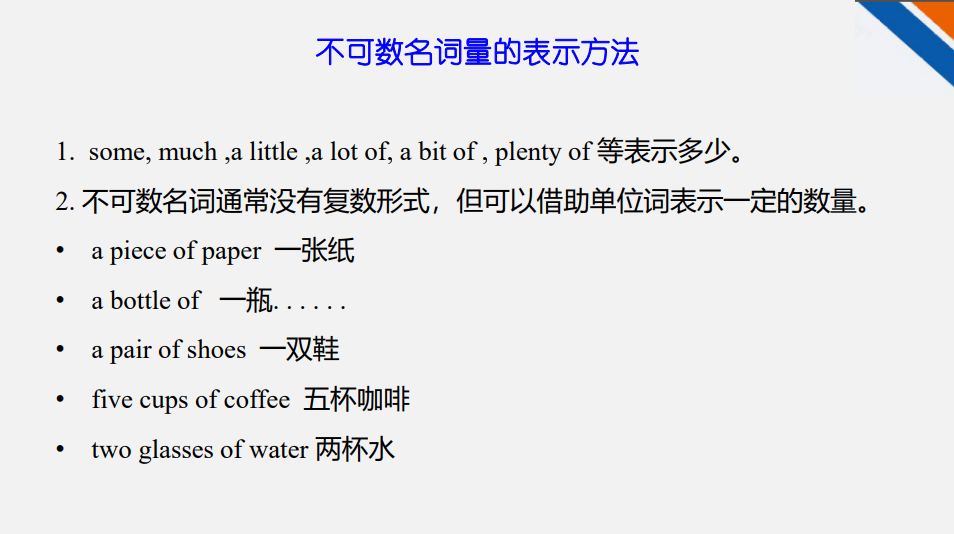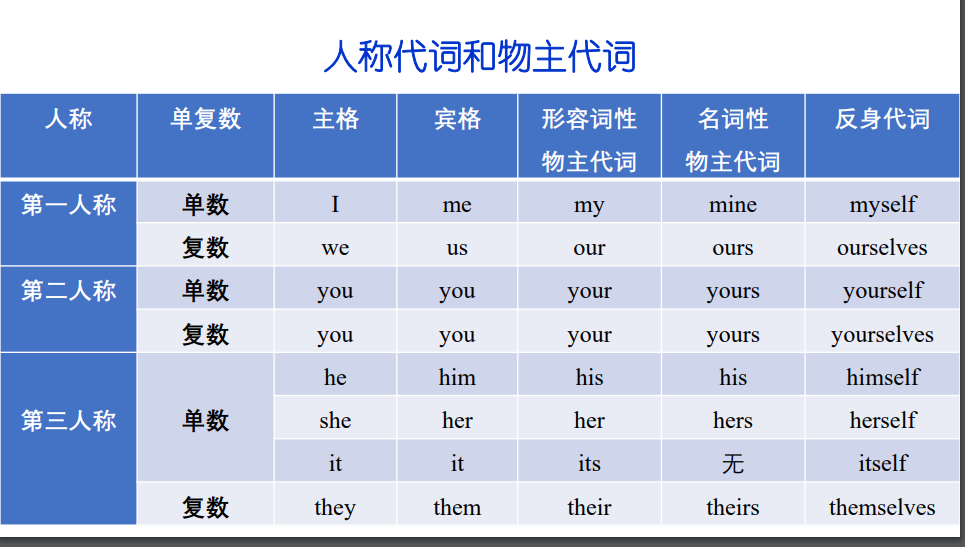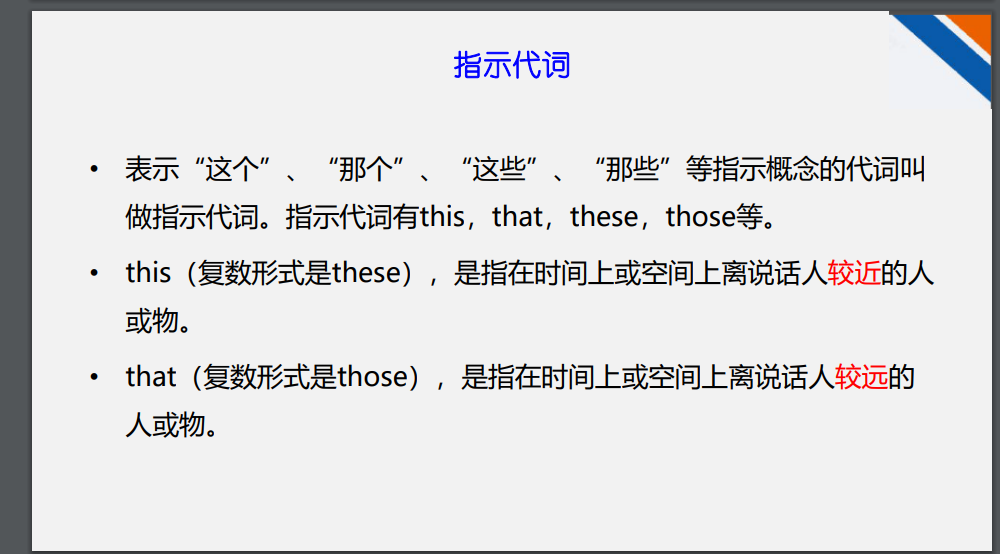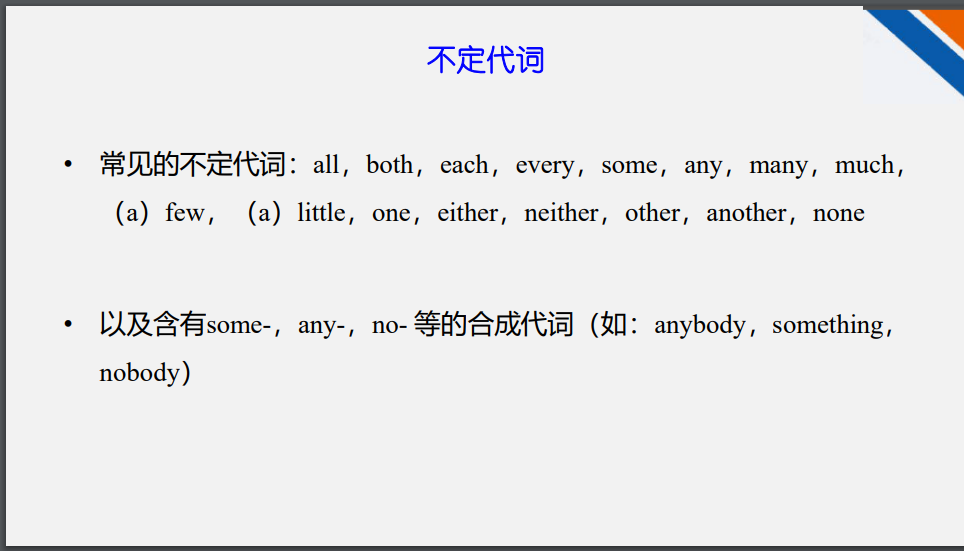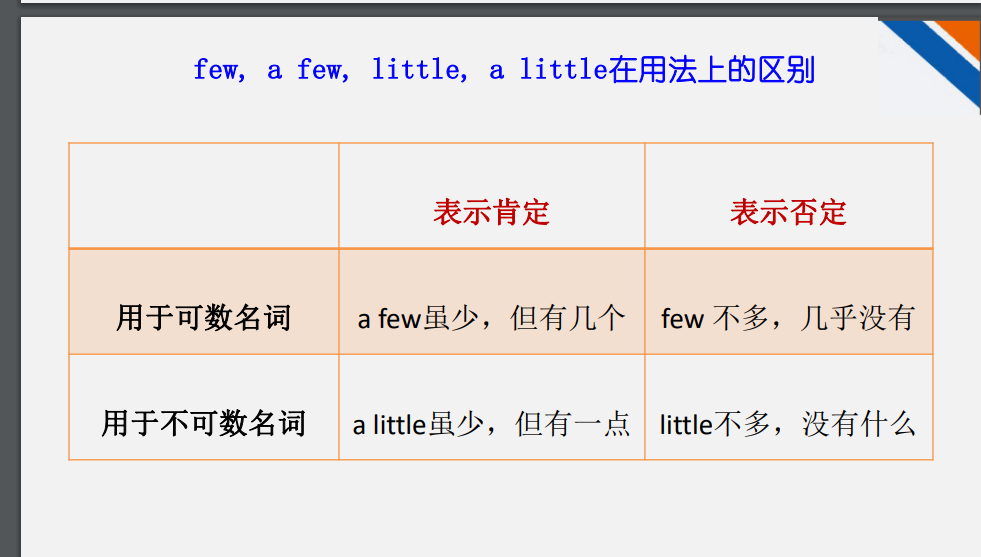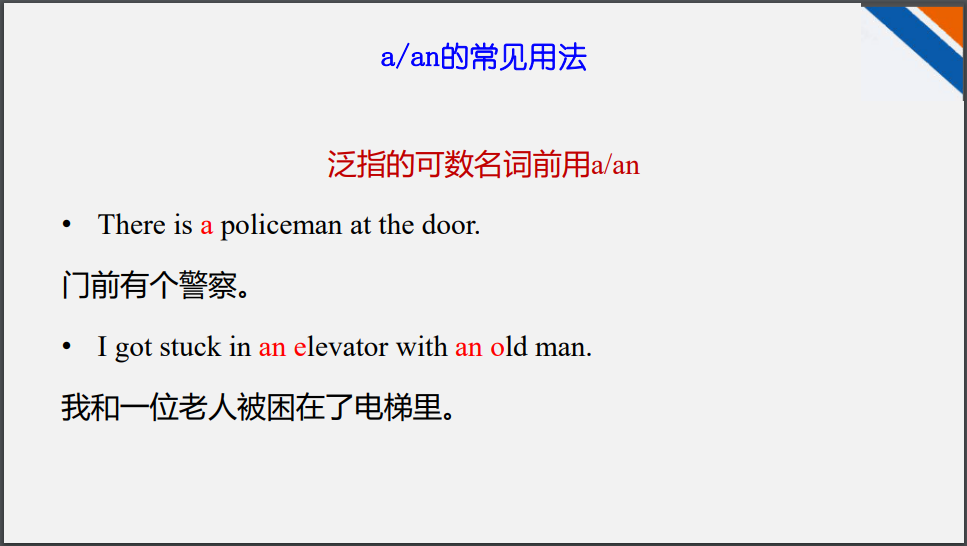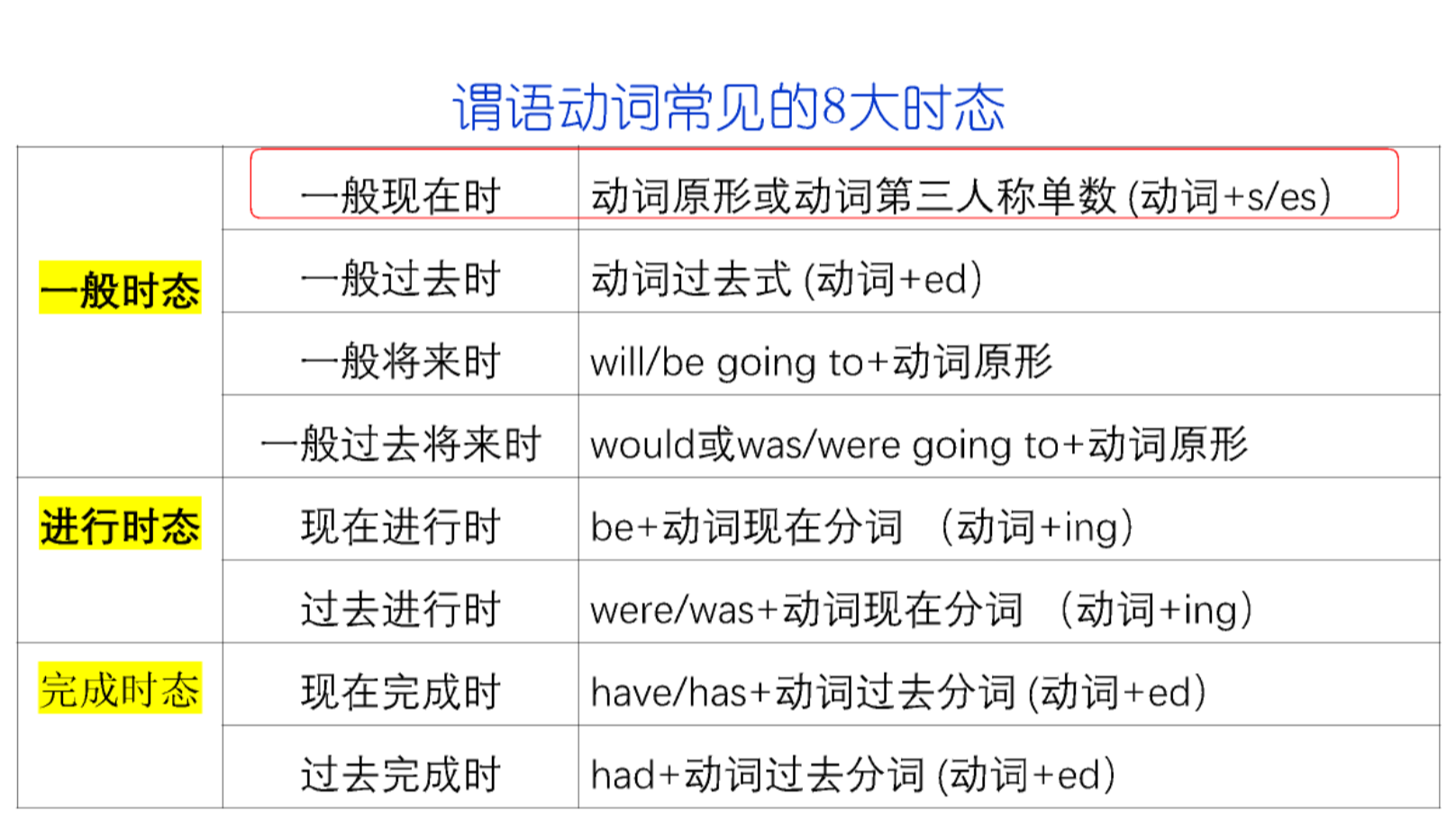8.7 KiB
8.7 KiB
基础
元音和辅音是什么?
- 元音(Vowels):
- 英语的5个元音字母:A, E, I, O, U
- 这些字母通常代表发音时气流不受阻碍的声音。例如:
apple中的 a、open中的 o。
- 辅音(Consonants):
- 除元音字母外,其他所有字母都是辅音字母(如:B, C, D, F...)。
- 辅音发音时气流会被嘴唇、舌头、牙齿等部分阻碍,例如:
big中的 b 和 g。
名词
可数名词
可以看见,有固定形状的名词 • 时间、距离等表示单位的名词
不可数名词
看不见的抽象概念或者没有固定形状的 名词
代词
人称代词
指示代词
不定代词
其他代词
冠词
形容词
形容词比较级和最高级
形容词比较级的构成
-
单音节形容词和部分双音节形容词:
-
直接在词尾加
-er
- tall → taller(更高的)
- small → smaller(更小的)
- fast → faster(更快的)
规则变化:
-
以
e
结尾的词,只加
-r
:
- nice → nicer(更好的)
-
以辅音 + 元音 + 辅音结尾的词,双写最后一个辅音再加
-er
:
- big → bigger(更大的)
- hot → hotter(更热的)
-
-
多音节形容词(通常三音节或更多)和部分双音节形容词:
-
在前面加
more
- beautiful → more beautiful(更美丽的)
- important → more important(更重要的)
-
-
不规则变化:
- good → better(更好的)
- bad → worse(更坏的)
- far → farther/further(更远的)
一、原级:as + 形容词 + as
用于表达两者在某个方面的程度相等。
结构:
- as + 形容词原级 + as:表示“和……一样……”
- not as/so + 形容词原级 + as:表示“没有……那么……”
例句:
- The weather is as cold as yesterday.(今天的天气和昨天一样冷。)
- This room is not as big as that one.(这个房间没有那个房间大。)
常见短语:
- as soon as possible(尽快)
- as far as I know(据我所知)
二、比较级:两者之间的比较
用于比较两个对象在某一方面的差异。
结构:
- 形容词比较级(+er)+ than:用于单音节和部分双音节形容词
- more + 形容词 + than:用于多音节形容词
例句:
- Tom is taller than Jack.(汤姆比杰克高。)
- This problem is more difficult than I thought.(这个问题比我想象的更难。)
特殊用法:
- 倍数表达:
- This room is twice larger than that one.(这个房间是那个房间的两倍大。)
不规则变化:
- good → better(更好)
- bad → worse(更差)
三、最高级:三者或以上的比较
用于在三者或更多对象中表示某个对象的程度最高。
结构:
- the + 形容词最高级(+est):用于单音节和部分双音节形容词
- the most + 形容词:用于多音节形容词
例句:
- This is the tallest building in the city.(这是这座城市最高的建筑。)
- She is the most intelligent student in the class.(她是班上最聪明的学生。)
不规则变化:
- good → the best(最好)
- bad → the worst(最差)
四、总结对比
| 类别 | 结构 | 例句 |
|---|---|---|
| 原级 | as + 形容词 + as | This book is as interesting as that one. |
| 比较级 | 形容词比较级 + than / more + 形容词 + than | She is taller than her brother. |
| 最高级 | the + 形容词最高级 / the most + 形容词 | This is the most expensive car I’ve seen. |
动词
时态+状态
1. 一般时态
1.1 一般现在时
-
结构:动词原形(第三人称单数加 s/es)
-
用法:描述习惯、事实、规律或现在的状态。
-
例句
:
- He plays basketball every day.(他每天打篮球。)
- The sun rises in the east.(太阳从东方升起。)
1.2 一般过去时
-
结构:动词过去式(动词 + ed,不规则动词有特殊形式)
-
用法:描述过去发生的事情或过去的习惯。
-
例句
:
- I watched a movie yesterday.(我昨天看了一部电影。)
- She went to school by bike.(她骑车去上学。)
1.3 一般将来时
-
结构:will / be going to + 动词原形
-
用法:描述将要发生的事情或计划。
-
例句
:
- I will visit my friend tomorrow.(我明天会去看我的朋友。)
- They are going to travel next month.(他们下个月打算去旅行。)
1.4 一般过去将来时
-
结构:would / was/were going to + 动词原形
-
用法:描述过去计划要发生的事情。
-
例句
:
- He said he would come.(他说他会来。)
- They were going to leave, but it started raining.(他们本打算离开,但下雨了。)
2. 进行时态
2.1 现在进行时
-
结构:be + 动词现在分词(动词 + ing)
-
用法:描述正在发生的动作。
-
例句
:
- I am reading a book.(我正在读一本书。)
- They are playing soccer.(他们正在踢足球。)
2.2 过去进行时
-
结构:was/were + 动词现在分词(动词 + ing)
-
用法:描述过去某个时间正在进行的动作。
-
例句
:
- She was cooking when I called.(我打电话时她正在做饭。)
- They were watching TV last night.(他们昨晚在看电视。)
3. 完成时态
3.1 现在完成时
-
结构:have/has + 动词过去分词(动词 + ed)
-
用法:描述从过去持续到现在的动作,或对现在有影响的动作。
-
例句
:
- I have finished my homework.(我已经完成了作业。)
- She has lived here for five years.(她在这里住了五年。)
3.2 过去完成时
-
结构:had + 动词过去分词(动词 + ed)
-
用法:描述在过去某个时间之前已经完成的动作。
-
例句
:
- He had left before I arrived.(我到之前他已经离开了。)
- They had finished dinner when we called.(我们打电话时他们已经吃完饭了。)
总结表格
| 时态类型 | 时态名称 | 结构 | 用法 |
|---|---|---|---|
| 一般时态 | 一般现在时 | 动词原形 / 第三人称单数 + s/es | 习惯、事实、现在的状态 |
| 一般时态 | 一般过去时 | 动词过去式 | 过去发生的动作或习惯 |
| 一般时态 | 一般将来时 | will / be going to + 动词原形 | 将来的计划或预测 |
| 一般时态 | 一般过去将来时 | would / was going to + 动词原形 | 过去计划的将来动作 |
| 进行时态 | 现在进行时 | be + 动词 + ing | 正在进行的动作 |
| 进行时态 | 过去进行时 | was/were + 动词 + ing | 过去某时正在进行的动作 |
| 完成时态 | 现在完成时 | have/has + 动词过去分词 | 对现在有影响的过去动作 |
| 完成时态 | 过去完成时 | had + 动词过去分词 | 过去某时之前已经完成的动作 |
